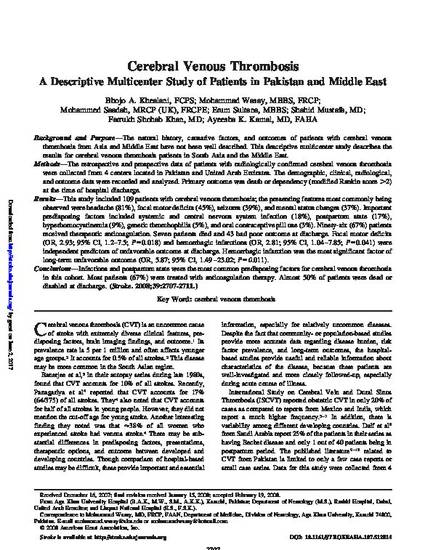
Background and Purpose— The natural history, causative factors, and outcomes of patients with cerebral venous thrombosis from Asia and Middle East have not been well described. This descriptive multicenter study describes the results for cerebral venous thrombosis patients in South Asia and the Middle East.
Methods— The retrospective and prospective data of patients with radiologically confirmed cerebral venous thrombosis were collected from 4 centers located in Pakistan and United Arab Emirates. The demographic, clinical, radiological, and outcome data were recorded and analyzed. Primary outcome was death or dependency (modified Rankin score >2) at the time of hospital discharge.
Results— This study included 109 patients with cerebral venous thrombosis; the presenting features most commonly being observed were headache (81%), focal motor deficits (45%), seizures (39%), and mental status changes (37%). Important predisposing factors included systemic and central nervous system infection (18%), postpartum state (17%), hyperhomocystinemia (9%), genetic thrombophilia (5%), and oral contraceptive pill use (3%). Ninety-six (67%) patients received therapeutic anticoagulation. Seven patients died and 43 had poor outcome at discharge. Focal motor deficits (OR, 2.93; 95% CI, 1.2–7.5; P=0.018) and hemorrhagic infarctions (OR, 2.81; 95% CI, 1.04–7.85; P=0.041) were independent predictors of unfavorable outcome at discharge. Hemorrhagic infarction was the most significant factor of long-term unfavorable outcome (OR, 5.87; 95% CI, 1.49–23.02; P=0.011).
Conclusions— Infections and postpartum state were the most common predisposing factors for cerebral venous thrombosis in this cohort. Most patients (67%) were treated with anticoagulation therapy. Almost 50% of patients were dead or disabled at discharge.
Available at: http://works.bepress.com/mohammad_wasay/137/
